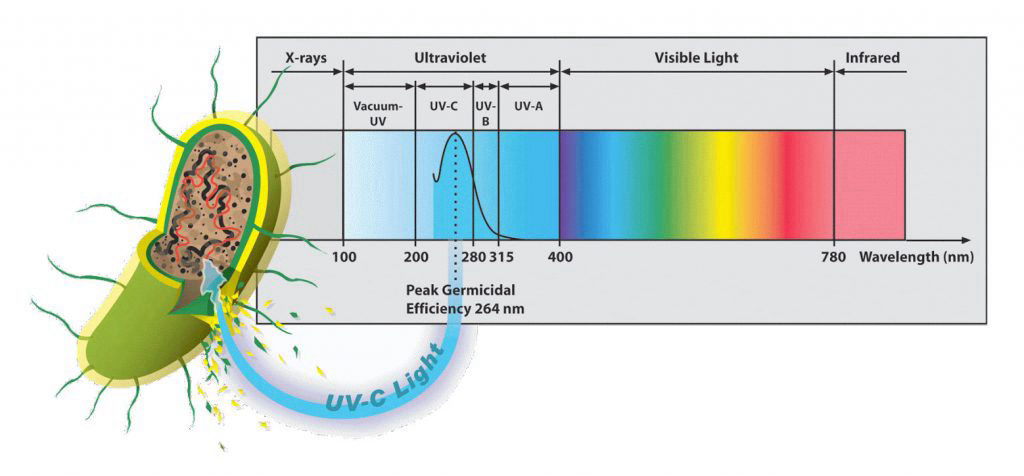UVC light is a form of ultraviolet light with properties that make it useful for disinfection.
UVC is a form of ultraviolet light with properties that make it useful for disinfection (find out more about what UVC light is).
In the simplest sense, a controlled blast of UVC light is delivered to a room, and kills the contaminants within it.
To be as effective and as safe as possible, this UVC light must be emitted by a specialised device, such as our own THOR UVC®. This will cause viruses and bacteria to be rapidly killed wherever the light touches, providing near-comprehensive disinfection of surfaces, air and objects within a room.
This happens because UVC light destroys genetical material. Specifically, the UVC light is absorbed by the proteins, DNA and RNA (ribonucleic acid, a vital component of all living cells and a carrier of genetic information) in any living cells reached by the UVC. The UVC then deactivates them. In the case of the proteins, it causes the rupture of cell walls. Meanwhile, it disrupts the functioning of the DNA and RNA, leaving the cells unable to replicate.

What types of viruses and bacteria can it kill?
The range of viruses and bacteria that UVC light can kill is theoretically limitless, and dependent only on the intensity and duration of the blast of UVC light.
For practical purposes, however, a sufficiently specialised and effective device such as THOR UVC® is able to comprehensively provide a terminal disinfection of almost every type of bacteria and virus it could reasonably be expected to contain, including ‘superbugs’ in medical settings.
Importantly, this includes coronaviruses such as COVID-19. A recent study by Boston University in conjunction with Finsen Tech’s emitter supplier Signify, concluded that the emitters used in our products can eradicate COVID-19 with a high degree of efficacy within minutes.
What are the potential limitations of UVC disinfection?
The biggest potential drawback to UVC disinfection is the risk of shadowing.
When corners or areas of rooms are not reached by the UVC light, remaining in shadow, this means that disinfection will not occur, and that any virus or bacteria organisms in these areas will remain alive and unaffected.
Eliminating the risk of this requires a device with features designed to obviate shadows. In the case of our THOR UVC® device, two separate design features are included for this purpose.
The first is our LIDAR-based room scanning. This is a detection system that is based on radar, but instead uses the light from a laser. It is used in some self-driving car technologies in order to help the car understand its position on the road relative to cars and other objects. It’s useful for UVC disinfection, because it enables the disinfection device to understand the size and shape of the room, and the quantity and position of objects within it.
The second feature is deployed on the basis of the information gathered by the room scanning. Emitters which are placed all the way across the device, from top to bottom, are deployed simultaneously to reach all areas. In parallel, the device telescopes upwards to ensure that its light reaches all areas of the room, and that no areas are left in shadow.
Our UVC solutions:
To find out more about THOR UVC® and HYPERION® for your facility, please email our international sales team or call us on:
UK: +44 (0) 207 193 5641
USA: +1 844 4 346736
Aus: +61 1300 665 884



